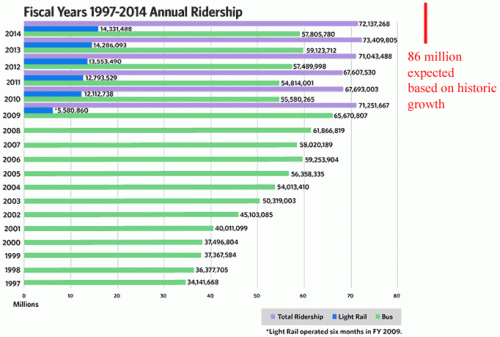Phoenix Light Rail Update: We Spent $1.4billion+ to Reduce Transit Ridership
Check this graph out from the Phoenix Metro web site. It shows bus ridership in years past, and more recently both bus and light rail ridership.
You can see a few things. First, note that almost all the rail ridership came at the expense of bus ridership. It was almost a pure 1:1 substitution. The bus ridership, even with a half year of light rail being open, was 65.7 million in 2009. Total ridership was only 67.6 million in 2010 and 2011. Yes there is a recession here, but of the 12 million or so in light rail ridership, at least 10-11 million of that came out of buses. Essentially, we paid $1.4 billion in capital costs to move 10 million riders to a mode of transit that is at least an order of magnitude more expense. Nice work.
Second, note that after over 12 years of growth, with the onset of light rail transit ridership has stagnated for 6 years. Some of this, at least initially, is likely due to the recession but in fact recessions are supposed to spur transit ridership, not reduce it, as people look for lower cost alternatives. There is a good explanation for this. Because light rail is so much more expensive, the cost per rider for the entire transit system has skyrocketed. With budgets unable to be increased this fast (and with fares covering only a tiny percentage of rail costs), the system must cut back somewhere. Since rail can't really be cut back, bus routes are cut.
If we had seen the same growth rate from 2009 to 2014 as we had seen in the twelve years prior, we should have over 86 million trips in 2014 (note these are fiscal years, and fiscal year 2014 is already closed, so this is not partial year data).
We paid, and continue to pay (since rail must be subsidized heavily) billions of dollars to reduce transit ridership.

Yes, but the real estate guys are over the moon. As you know it's all about development not transit. Mesa at least admitted as much when they embarked on their one mile boondoggle.
City rail lines will be necessary in the near future to move the people to the furnaces . Remember that work makes you free.
Government in action. As it ever was, so it shall ever be.
What would be really interesting and informative would be some true investigative journalism into who profited from the light rail debacle. Follow the money to see why this project was done. Who approved it and who were their contributors, legal and under the table. Who constructed it, and who did they contribute to, above and below the table. Who owned the land that was used and how did that land change hands shortly before approval/construction. ETC.
Follow the money for a real story.
Coyote, who are all these Arizonans who believe in light rail, and do they dream of regular train service to Yuma? Are they retirees from Islip nostalgic for the daily trip to Manhattan?
In bankrupt Detroit, they are running a light rail up the main thoroughfare. It's pure insanity that the first thing they do is increase their fixed expenses.
The miniscule increase in total ridership (<2%) between 2010 and 2014 could easily be accounted for by the double-counting of transfers as ridership, as bus routes are often restructured to serve new rail lines when they are built. This would help to explain why the rail-for-bus substitution wasn't exactly one-for-one in the ridership numbers. And, as you mention, this increase is well below historic rates of growth in the fast-growing Phoenix region.